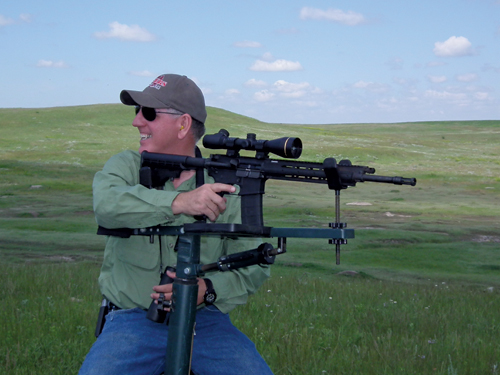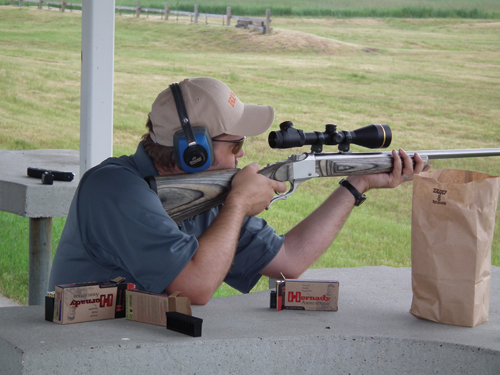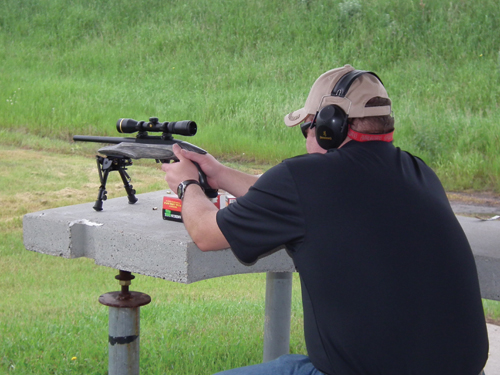As I landed in Bismarck, North Dakota, my thoughts were more with the flood-ravaged residents of the town (and Minot, to the north) than with the prairie dogs I was hoping to shoot. The Missouri River had overflowed to the size of the Mississippi in Bismarck and things were even worse in Minot.
 I had come in to help Ruger’s Ken Jorgensen thin down the region’s prairie dog towns, but for two days steady rains put an end to back-road driving. We busied ourselves at a local range, sighting in a truckload of Ruger’s best varmint-style rifles and handguns. The majority of prairie dogs would be shot at around 300 yards, and tuning up a dozen single-shot, semi-auto and bolt-action rifles was a challenge as continuous downpours hid the targets from us. Even with careful shooting we were unable to squeeze the maximum accuracy out of the collection of .223 Remington, .204 Ruger, 6.5 Creedmoor and .22 rimfires Ken had brought out for testing and evaluation. When it came down to brass tacks (in a driving rain) we decided that shooting tight groups at 25 yards was our best bet. A little ballistic extrapolation was all we needed to take care of business when (and if) we hit the prairie dog towns later in the week.
I had come in to help Ruger’s Ken Jorgensen thin down the region’s prairie dog towns, but for two days steady rains put an end to back-road driving. We busied ourselves at a local range, sighting in a truckload of Ruger’s best varmint-style rifles and handguns. The majority of prairie dogs would be shot at around 300 yards, and tuning up a dozen single-shot, semi-auto and bolt-action rifles was a challenge as continuous downpours hid the targets from us. Even with careful shooting we were unable to squeeze the maximum accuracy out of the collection of .223 Remington, .204 Ruger, 6.5 Creedmoor and .22 rimfires Ken had brought out for testing and evaluation. When it came down to brass tacks (in a driving rain) we decided that shooting tight groups at 25 yards was our best bet. A little ballistic extrapolation was all we needed to take care of business when (and if) we hit the prairie dog towns later in the week.
Even though flooding devastated the major river-corridor cities, the prairie dog towns an hour away were high and dry—and full of targets! As always, I was surprised and amazed at the size of the prairie dog towns we hunted. Well off the main roads and two or three gates back in, the best towns were huddled between two hills, out of sight of casual highway observers. Most towns were a mile or more in length. Because these towns had been under siege from a variety of .22 shooters over many years, the dogs knew that their hides were safe outside 200 yards. We rarely saw a target closer than that, but even with 30X spotting scopes we could not see the last of the dogs standing up on the fringes of the town.
The prairie dogs began to risk their lives at 200 to 250 yards, and we made quick work of them. Beyond 300 yards it was a shooter’s game, with spotters calling out the misses and shooters making their adjustments. I’d take a break every 200 rounds or so (mirages were brutal during the heat of the day), but after a cold drink and a short rest I’d be back in the game for another hour or two.
When prairie dog shooting becomes a group exercise, long-range shooting is the theme of the day. Every shooter should have a flat-shooting, scoped (9X and up) rifle fitted with a bipod or tripod, or better yet, a portable bench. Few dogs will show up under 200 yards (even though thousands of fresh holes assure their presence), so shooters may set up wherever a convenient flat spot (free of sunning rattlesnakes!) allows.
For serious long-range dogging, it’s almost futile to shoot without a spotter, whose job it is to point out distant dogs, get the range, watch bullets impact into the dirt around the distant dog and offer the necessary corrections. On my windy-day shoot, I started listening to my spotter after the third miss. It seemed incredible to me that I could be three feet off target at just 300 yards, but puffs of dirt don’t lie! Next shot went into the chest of the spellbound dog, and after that I went something like 10 straight without a miss—in winds that would literally knock your hat off. A good spotter is worth his weight in lead—don’t go to Dog Town without one!
Whenever possible or necessary, pick up and move another 200 yards to the left or right, go over the hill or to another part of the dog town where more targets and better conditions may be found. Remember, however, that when large groups show up to shoot the closer dogs will stay underground till the smoke clears.
Another point that’s important to all-day shooters is that the best prairie dog towns are often many miles away from supply points. Bring all the food, water, ammunition, clothing, rain gear and other gear you will need with you or do without it. Remember to bring hearing protection (each gunner will likely go through 200 or more rounds in a session—more if the dogs are plentiful and suicidal!). Rifles should be on a sling (for easy carrying) and gear should be in sturdy, lightweight boxes. Most shooters will end up carrying a rifle and two boxes for 300 yards or more away from the truck, so be prepared to do some hauling! There may also be mosquitoes to contend with, and disease-carrying fleas can also be a problem, so use the appropriate insect repellents. Dress in light clothing (it gets hot out there) and use sunscreen when necessary.
Excellent lodging and meals are available in Bismarck and Minot, ranging from everything like convenience store sandwiches to top-end dining – and jeans and cowboy hats are always welcome. Hunting licenses ($15 for non-residents) are available at Scheel’s Outfitters and other outlets, or hunters may purchase licenses online at http://gf.nd.gov. For more information about North Dakota’s great prairie dog shooting, log onto www.ndtourism.com or call (701) 328-2532. To find out more about the shooting opportunities in and around Bismarck and nearby Mandan, contact my spotter, Kelvin Hullett, www.bismarckmandan.com. For details on hunting options near Minot, log onto www.minotchamber.org.
My overall assessment is that North Dakota is a top-notch place to be for great shooting, great accommodations and some of the nicest people you’ll ever meet in the “welcome to our state” business. Red carpet treatment is the order of the day – every day. Problems are solved immediately and itineraries are always adjusted to the visitor’s requirements. I have never been to a place where chamber of commerce and tourism staff were more helpful, accommodating and affable. Final word: Get yourself to North Dakota and see what real prairie dog shooting is like!
Guns and Gear
 Riflemen heading for North Dakota for a prairie dog shoot need look no farther than Ruger’s proven line of rifles and handguns. Everything in the company’s time-tested line of rifles and calibers ranging from the 6.5 Creedmoor to the time-tested Ruger No. 1 and even the new AR lineup performed well under fire with no malfunctions or misfires. Functioning was flawless even after a full week of shooting by 13 different gunners.
Riflemen heading for North Dakota for a prairie dog shoot need look no farther than Ruger’s proven line of rifles and handguns. Everything in the company’s time-tested line of rifles and calibers ranging from the 6.5 Creedmoor to the time-tested Ruger No. 1 and even the new AR lineup performed well under fire with no malfunctions or misfires. Functioning was flawless even after a full week of shooting by 13 different gunners.
At distances under 200 yards, all of the calibers we tested (.22 rimfire, .223 Rem., .204 Ruger and 6.5 Creedmoor) were spot-on. But, some shooters and rifles seemed to meld well, and when the distances increased to 300 and 400 yards and beyond, the standouts were appreciated by one and all.
Topping the list of “Oh, wow!” calibers was the .204 Ruger, which seemed to slay prairie dogs with dead-on holds from 100 to close to 400 yards. It was absolutely the flattest-shooting gun in the batch. Next in the “awesome” line was the new, improved R-556 E, surprising because its short barrel and slimmer lines would have some suggest that it would not keep up with the original R-556. But, when properly sighted in (three inches high at 100 yards) the “E” was on target out to 325 yards or so—and ripped through 30-round magazines flawlessly, all day, every day.
 The biggest surprise of the trip was Ruger’s new Charger .22 pistol, which sharp eyes will identify as a cut-down version of the 10/22 semi-auto rifle. Properly equipped with a scope with appropriately long eye relief, the Charger tipped row after row of silhouettes at the range and was equally deadly on prairie dogs out to 175 yards – not bad for a .22 Long Rifle! With a 10-shot clip, Harris bipod, and fitted with either a Burris, Leupold or Trijicon scope, the Charger quickly drew the attention of the riflemen in the crowd and, by trip’s end, everyone had downed a dog or two with this remarkably-accurate handgun.
The biggest surprise of the trip was Ruger’s new Charger .22 pistol, which sharp eyes will identify as a cut-down version of the 10/22 semi-auto rifle. Properly equipped with a scope with appropriately long eye relief, the Charger tipped row after row of silhouettes at the range and was equally deadly on prairie dogs out to 175 yards – not bad for a .22 Long Rifle! With a 10-shot clip, Harris bipod, and fitted with either a Burris, Leupold or Trijicon scope, the Charger quickly drew the attention of the riflemen in the crowd and, by trip’s end, everyone had downed a dog or two with this remarkably-accurate handgun.
For more information on Ruger’s lineup of dog-ready firearms, log onto www.ruger.com.






